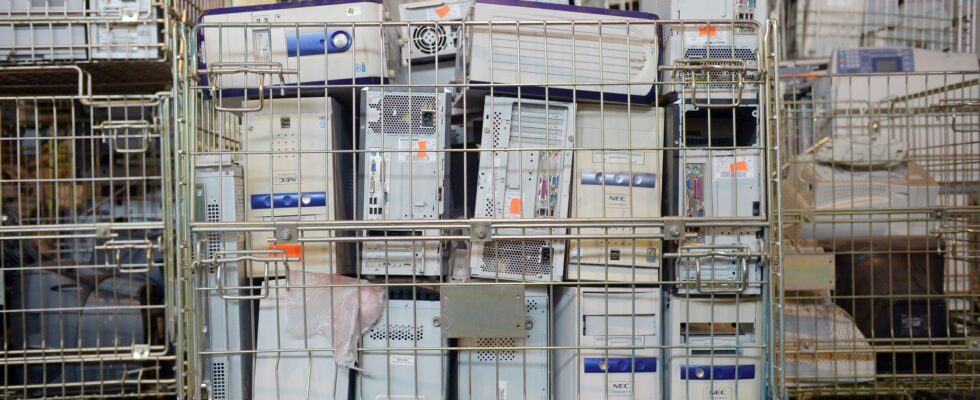In the era of ChatGPT, TikTok, and hours spent watching series on Netflix, it is sometimes easy to forget that digital pollutes. However, the analysis of the trend scenarios for 2030 and 2050 shows that this sector is not yet part of “a dynamic of decarbonization and reduction of environmental impacts in opposition to the commitments made by France”, according to analysis published Monday, March 6 by the Agency for Ecological Transition (Ademe) and the Regulatory Authority for Electronic Communications, Posts and Press Distribution (Arcep). Responsible since August 2020 for measuring the environmental impact of digital technology in France, the two organizations had already shown that the carbon footprint generated by digital goods and services in France in 2020 represented 2.5% of that of the country, i.e. approximately 17 million tons of CO2.
In the future, this environmental bill could explode. “It emerges from this analysis that, if nothing is done to reduce it, the digital footprint would almost double by 2030 and could even triple by 2050”, warns Arcep. It would thus represent more than 49 million tonnes of CO2, i.e. double the emissions of French air traffic in 2019. The consumption of metals and minerals, for its part, would more than double.
In particular, terminals – mainly televisions – but also computers, Internet boxes and smartphones. Added to this are connected objects whose impact is growing. Contrary to popular belief, these devices represent the largest part of the digital carbon footprint (nearly 80%), data centers – or data centers – being responsible for only 16% of these emissions.
Frugality as a horizon?
Making this observation, the authorities are proposing several more or less optimistic scenarios based on different complementary solutions, ranging from the use of sobriety to the development of green technologies, via a society in which tech interferes everywhere. This last path, the most daring, is then based on the hope of performance gains at all levels: “This exclusive support for technologies is a gamble insofar as some of them are not mature”, warns however Ademe, without specifying which ones. This is in fact the worst case scenario in terms of environmental impact, since it would lead to a quadrupling of greenhouse gas emissions by 2050.
In all these scenarios, the environmental footprint of the digital sector would continue to increase by 2050. But an ultimate trajectory, which is favored by Arcep and Ademe, and which is based on the notion of “frugality “, would, however, reverse the trend. In this model, consumers, businesses, and utilities would disrupt their habits by using less equipment and would need to stick with it for an average of two more years. All this in a world where eco-design and reconditioning of terminals have become the norm. By 2030, this would reduce the sector’s CO2 emissions by 16%, and the consumption of minerals and metals by 30%. “Only radical ecological sobriety will allow us not to miss out on environmental issues”, abounds with L’Express Frédéric Bordage, from the GreenIT study firm.
Arcep and Ademe admit it: these changes in behavior are “very important compared to the habits that have taken hold since the rise of digital technology”. A recent study conducted by the agency We Are Social, centered on the uses of the French in 2022, offers an overview of the magnitude of the task. Not only are uses stable or increasing, like the time spent on social networks (1h46 per day on average in 2022, +5 minutes compared to 2021). But more and more French people are equipping themselves with new terminals, sometimes with double-digit growth rates. For example: more than 20% now wear a connected watch or bracelet. Objects connected to the home also increased by 23% in 2022 compared to 2021. This development is anticipated by Ademe and Arcep, which estimate the overall growth of terminals at 1.3 billion in France by here at the end of the decade. Alas, it would take three times less to stick to the so-called “frugal” trajectory.
Changing our habits
The ball is now in the court of the government, which wants to use this data to establish “by June 2023 an ambitious roadmap for decarbonization”, we know at the Ministry of the Economy. “Public authorities, European and national, are pushing to demand a radical change in terms of eco-design, warranty period and repairability from manufacturers and distributors”, underlined the Minister Delegate for Digital, Jean-Noël Barrot. , when submitting the report.
France can boast of some successes in imposing rules on manufacturers often based outside Europe, such as Apple or Samsung. This is the case of the repairability index, introduced two years ago. Or, at European level this time, the implementation of a single USB-C charger, aimed at reducing the amount of electronic waste. But there have also been failed appointments. “The Reen law, of November 2021 on the reduction of the environmental footprint of digital technology, had failed to adopt coercive measures”, recalls Frédéric Bordage.
However, time is running out. The risk, reminds the expert, is to soon have no choice. “With the scarcity of available metals, the general public must understand that digital is a non-renewable resource. Choices must be made: do we want bigger televisions or scanners in hospitals?” Ademe and Arcep basically say nothing else: “These changes towards more sobriety could also be necessary following situations of shortages of raw materials […] essential to the ecological transition”, remind the authors. Digital leisure could then be limited to a sober use and reserved for the fields of health, education, or culture. In this case, the viewing of a series Netflix on the bus would probably become more complicated…
